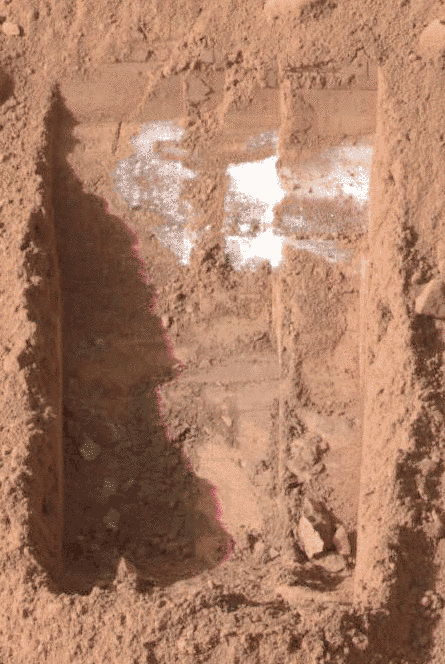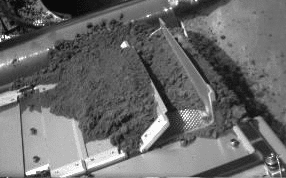Emily Lakdawalla • Jun 20, 2008
Yep, it's ice!
The Phoenix mission confirmed it this morning: the disappearing act pulled by those chunks of bright material in the Dodo trench pretty much nails the identification of the bright material as ice, which is great news for the mission. Ice is what Phoenix went all the way to Mars to study; it's what the team has been aiming for all these years. They expected to find it, but all this time, doubters and worriers (myself among them) have been asking, privately and publicly, what happens if they get there and can't reach ice? Well, that worry, it seems, has been dismissed. "This is final proof to our science team that we are looking at ice, and not some other substance," Peter Smith said in a teleconference today. Mark Lemmon said "I can verify from imaging data that we've found exactly what we went to Mars to look for. We can reach out and touch the ice on Mars now."
I'd have a more full report on today's media teleconference but I don't have a babysitter on Fridays so I was alternately having a tea party, reading a book, watering the plants, doing puzzles, reading another book, and so on, as the teleconference proceeded. Fortunately A. J. S. Rayl was available to cover the telecon, so you should see a full report from her on our website later today; watch the home page (or subscribe to our RSS feeds) to see that.
I'll just post here an animation of the disappearing act, similar to the one created by Daniel Crotty that I posted last night, except that it's made of two images that came directly from the imaging team and so were made from calibrated (and thus far more trustworthy) data.

Many people have been asking me, can't this be carbon dioxide ice? It's true that carbon dioxide ice can form on Mars. However, the ambient temperature at the Phoenix landing site is way too high for it to be stable for even a couple of hours. Mark likened it to the stability of water ice on Earth at a temperature of 140 degrees Fahrenheit (60 Celsius -- it's funny, Mark, like me and a great many other American scientists, is perfectly comfortable with metric units for almost everything except Earth temperatures). It won't vaporize instantly, but it won't stick around long. The biggest chunks in the trench survived at least one sol, but disappeared after two or three, which is exactly consistent with the predicted behavior of water ice, but not with carbon dioxide ice.
Also, Barry Goldstein was on the panel today. I didn't have a chance to ask questions, but he did mention briefly that the sol 22 problem is under control, and they're working toward a solution. He said "We understand the issue quite well, so there is little restriction on science team except that they have to downlink data as they acquire it," that is, they can't save anything overnight. This probably affects the imaging team the most, although Mark has commented to me that his camera is only one of "two and a half data hogs" on the mission. I'm not sure what the other one and a half hogs are. I'll try to follow up with the issue on Monday.
I've updated my Robotic Arm Camera raw images page. There's lots of stuff from sols 22 and 25. But there was something worrisome on sol 25. On sol 25, they commanded the opening of the next TEGA oven, oven 5. Remember how one of the two TEGA doors for oven 5 didn't open completely, back on sol 8? Well, that incomplete opening seems to have happened to both the doors on oven 5. There's only a tiny slit of space open for soil to fall through. This problem is really hard to figure out. Here's what I can tell you: the doors have no motors -- they are spring-loaded and have a latch, just like a jack-in-the-box (except no toy pops out to scare you when the doors open). To open the doors, you command the latch to release the spring. The springs were designed to be powerful enough to open the doors even underneath a heavy load of dirt. So if the doors aren't open all the way, there's nothing they can do to command them to open further. They can try to shake TEGA, but that's about it; and all the vibrating they did to oven 4 failed to move that door at all. I don't have any further insight into the problem -- it's really befuddling. But it looks like something in their design, which must have been tested very thoroughly here, is not working under Martian temperature or gravity conditions, or something happened during the cold of cruise or shock of launch and landing. It's very mysterious.

I'm a little worried that by even discussing the sol 22 anomaly and the TEGA door opening difficulties, I might be seen as a "negative Nellie," focusing excessively on bad news. To explain myself: one of the reasons that space exploration is so exciting is because it's difficult. All missions face challenges, and the people on the teams always rise to the occasion, coming up with incredibly creative solutions, either solving the problems, or figuring out new ways to accomplish the mission's goals despite the difficulties with some components. And sometimes, problems yield unforeseen payoffs -- just look at how Spirit's stuck wheel dragged up silica soil near Home Plate, for instance, or how the blur in the Deep Impact high-resolution camera's optics is facilitating the study of extrasolar planets. Space exploration isn't just about the thrill of new discoveries, it's about the challenge of exploration itself, and watching a mission respond to those challenges is inspiring. So I'll keep writing about both successes and setbacks, but I do it out of love, honestly!
Support our core enterprises
Your support powers our mission to explore worlds, find life, and defend Earth. You make all the difference when you make a gift. Give today!
Donate

 Explore Worlds
Explore Worlds Find Life
Find Life Defend Earth
Defend Earth

